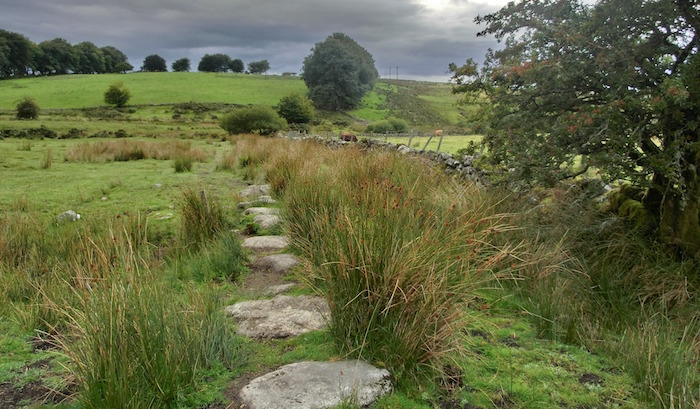Once a month here on the Molten Sulfur Blog, I run content taken from our book Archive: Historical People, Places, and Events for RPGs. This post is one of eighty entries in Archive, each more gameable than the last!
This post is brought to you by beloved Patreon backer Justin Moor. Thanks for helping keep the lights on! If you want to help keep this blog going alongside Justin, head over to the Patreon page – and thank you!

Dartmoor
A Bleak Beauty
Dartmoor National Park is 365 square miles of heather-clad moorland, wide open landscapes, rushing rivers, and obscure stone tors in southwest England. There are rolling valleys, bogs, waterfalls, and well-trodden paths weaving through lush forests and village ruins. Dozens of small villages dot the landscape. Some are hamlets of thatched cottages and rambling lanes, while others are historic market towns with traditional stores, tearooms, and the occasional castle or two. An eruption of granite 250 million years ago lifted the softer rocks of the earth’s surface, accounting for the region’s unique stone formations and granite outcrops. Dartmoor was once a royal forest in Saxon times, belonging to the royal duchy of Cornwall since 1337. In 1951, it was designated a national park. Dartmoor can be separated into north, south, east, west, and central regions.
The northern region is more rugged and wild, with bogs that require care when traveling through. Some towns are nestled in the northern foothills of Dartmoor’s two highest peaks, while abandoned villages are overrun with lush vegetation and wildlife. The western region is easily accessible from Plymouth, so it is home to some of the more populated villages like the ancient town of Tavistock. The town hosts a huge selection of old shops and a bustling farmer’s market. In autumn, it comes to life with festivals and fall fairs. South Dartmoor is a tamer area, with a railway that connects some of the larger towns that used to thrive on trade. In one of the towns, there is an ale-tasting and bread-weighing ceremony at the end of every July.
East Dartmoor is home to the Fernworthy Reservoir and shaded woodlands. The eastern town of Chagford boasts a lively community of artists and musicians who derive inspiration from the beautiful moorlands. Central Dartmoor is the most iconic area of the park. The famous town of Princetown houses an austere and forbidding prison, and Sir Arthur Conan Doyle supposedly found inspiration in Princetown when writing Hound of the Baskervilles. Princetown is known for carrying Dartmoor’s folklore, brimming with tales of pixies, ghosts, witchcraft, and supernatural happenings.
Outside the towns, there is nothing but the Dartmoor wilds. Near villages, ancient stone walls border grassy pastures full of Galloway cattle and Dartmoor ponies. In May and June, the fields explode with the vibrant colors of thousands of bluebells. Butterflies and dragonflies flourish in open areas, while the woods and moor farther from towns house wild ponies. In open, sunlit glades in the oak woodland, the yellow heads of wild daffodils bloom in early spring. Rivers flow through the woods, filled with salmon and brown trout that are hunted by otters and goosander. Some rivers lead to the steep valleys of Dartmoor, where the current carves through rocky twists and turns. Foaming swirls of rough white water lead to calmer sections where ravens and buzzards circle above and kingfishers dip in and out of the stream. Paths in these valleys are narrow and dangerous.
Dartmoor in Play
At the table, there’s enough folklore floating around Dartmoor to fuel a magical fantasy campaign. There’s the mystery of why flowers bloom every day at the crossroads grave of a pregnant woman who committed suicide after her lover disowned her. Some locals say pixies make the flowers bloom, but maybe your party discovers that her lover and his descendants have been planting fresh flowers there every day. More lurid is the folktale of the Cutty Dyer, an evil spirit that supposedly lives in the South Dartmoor village of Ashburton. He slits the throats of drunkards, drinks their blood, and tosses them in the river. Your party could discover the tale was invented by a twisted serial killer to deflect attention away from her. Your PCs could also venture into the ruins of abandoned villages scattered throughout Dartmoor, searching for forgotten valuables or escaped convicts from the prison in Princetown.






